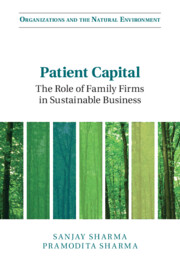Book contents
- Patient Capital
- Organizations and the Natural Environment
- Patient Capital
- Copyright page
- Contents
- Figures
- Tables
- Preface
- 1 Definitions
- 2 Primary Data: Cases from the Winery Industry in Canada, France, and Chile
- 3 Exogenous Drivers of Corporate Environmental Sustainability Strategy
- 4 Organizational Drivers of Corporate Environmental Sustainability Strategy
- 5 Managerial Drivers of Environmental Sustainability Strategy
- 6 Bringing the Family into the Corporate Environmental Sustainability Strategy: Implications for Research, Education, and Policy
- Index
- References
5 - Managerial Drivers of Environmental Sustainability Strategy
Published online by Cambridge University Press: 12 July 2019
- Patient Capital
- Organizations and the Natural Environment
- Patient Capital
- Copyright page
- Contents
- Figures
- Tables
- Preface
- 1 Definitions
- 2 Primary Data: Cases from the Winery Industry in Canada, France, and Chile
- 3 Exogenous Drivers of Corporate Environmental Sustainability Strategy
- 4 Organizational Drivers of Corporate Environmental Sustainability Strategy
- 5 Managerial Drivers of Environmental Sustainability Strategy
- 6 Bringing the Family into the Corporate Environmental Sustainability Strategy: Implications for Research, Education, and Policy
- Index
- References
Summary
A firm’s managers have the most intimate understanding of the firm’s business, customers, processes, and capabilities. The managers’ decisions are influenced not only by institutional forces, stakeholders, and organizational governance and leadership but also by their personal values toward sustainability, attitudes toward their roles in solving environmental sustainability challenges, cognitive frames, and interpretations of environmental issues as threats or opportunities. Managers remain locked into everyday routines, patterns of thinking, and cognitive biases that may stifle creativity.Firms that develop successful PES strategies create the opportunities for employees to apply fresh ideas and strategic thinking to address sustainability challenges by enabling them to overcome their biases and everyday routines. Family firms have some unique features that influence strategic decision-making by managers (which includes the family members) differently as compared to non-family firms. Managers in family firms that aim for trans-generational continuity of their enterprise will make decisions differently when addressing environmental issues.
Keywords
- Type
- Chapter
- Information
- Patient CapitalThe Role of Family Firms in Sustainable Business, pp. 150 - 194Publisher: Cambridge University PressPrint publication year: 2019



